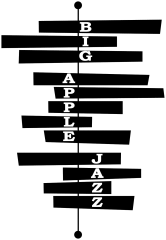New York City, NY
The Harlem Jazz Scene – a retrospective on the day after St. Nick’s Pub fire
The Harlem Jazz Scene – a retrospective on the day after St. Nick’s Pub fire
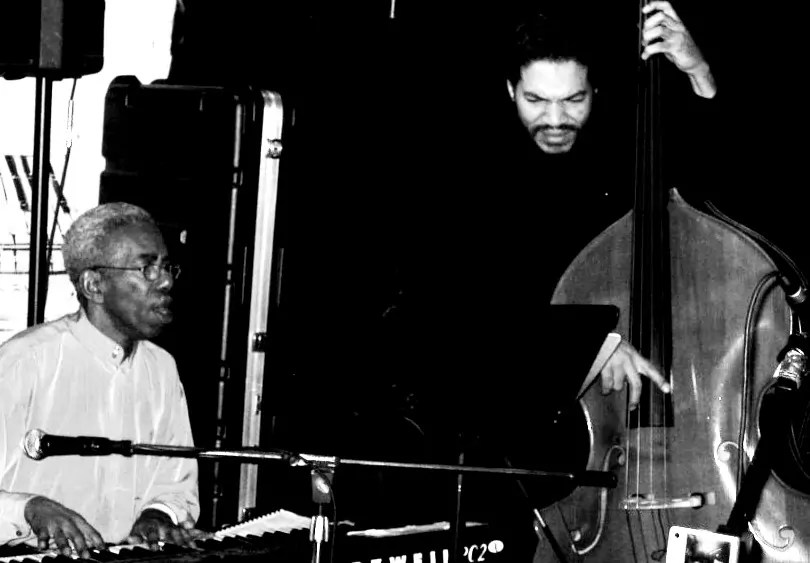
We woke up to the devastating news of a deadly fire last night in Harlem on the set of a Edward Norton, Bruce Willis, Alec Baldwin, Willem Dafoe, Leslie Mann movie called Motherless Brooklyn. With that kind of star power glaring their vision, what reporters so far have overlooked is that the charred set of this movie was in the defunct and deserted St. Nick’s Pub which closed 7 years earlier this same month.
As Harlem jazz fans wake up to this news through word-of-mouth, I wanted to resurrect an article I wrote nearly 10 years ago, describing the uptown jazz scene when it was truly in it’s 21st century heyday – when St. Nick’s Pub and the Lenox Lounge were still swinging and Earl Spain was still the proprietor of the Uptown Lounge at Minton’s Playhouse. St. Nick’s Pub was given the reputation of “bringing jazz back to Harlem.” Ask anyone who was there: they knew they were in the right spot at the right time, and have daily mourned it’s closing ever since. Now as the building at 773 St. Nicholas still smolders, we wonder if this is the true end of an era or a catalyst to start over? – GP March 23, 2018
The Harlem Jazz Scene 2009
by Gordon Polatnick
Harlem is Cinderella waiting to get asked to the ball. She’s beautiful, has a big heart and despite her glorious beginnings has been languishing in an abused state for far too long. The fairy godmother in the story – the thing with the magic touch—is the music.
Since the 20’s and 30’s when the Cotton Club introduced us to Duke Ellington, Cab Calloway and Lena Horne till today, Harlem’s music scene has always been one jump ahead of the world and always showing the way. Most of the old clubs, theaters, speakeasies and ballrooms are long gone with a few notable exceptions. What you’ll find today is not a throwback-nostalgia but an eager and energetic resurgence of a culture built on a solid and traditional foundation of funkiness.
Required reading on the subject is Mezz Mezzrow’s landmark 1946 memoir, Really the Blues. The mighty Mezz hips the reader to the Harlem that he found in the 1920’s and 30’s as he chased after Louie Armstrong to the epicenter of the cultural explosion known as the Jazz Age. It was during this prohibition era heyday of Harlem when cannabis was legal and booze illegal that the Harlem nightclub and speakeasy scene really captured the world’s attention. Times Square was square compared to its uptown counter-culture counterpart five miles north on 7th Ave.
The Stroll, 7th Ave. between 131st and 132nd Streets, was where you could enjoy the beat of the Harlem Renaissance –perhaps at a musical revue of Eubie Blake and Nobel Sissle at the Lafayette Theatre, or next door at Connie’s Inn where Satchmo was imported to play and sing Fats Waller and Andy Razaf’s Ain’t Misbehavin’ in Connie’s Hot Chocolates. Nowadays, this same broad avenue which hosts the ghosts of Harlem’s storied past, has three obscure artistic markers and a newly planted Tree of Hope to point locals and visitors back to where it all started. There are several nearby venues tucked away on brownstone-lined streets where one is encouraged to stray off-the-beaten-path to find the contemporary soul of Harlem’s music scene.
For the past ten years, Hammond B3 organist, Seleno Clarke, has been leading a humble yet essential jam session at the local American Legion Post (248 West 132nd Street) every Sunday evening. In Harlem, where every lounge in the 1960’s is said to have had a Hammond B3 churning out soul jazz late into the night, these days there are only two to be heard. For a taste of what was, check out Jimmy Smith’s 1957 live recording: Groovin’ at Smalls Paradise (that club with its 60 year history is now a popular International House of Pancakes (IHOP) at 135th and 7th Avenue). Clarke, who closed the original Minton’s Playhouse and came up in the scene with the likes of George Benson (known to visit the Post jam session from time to time), has consistently put together an international band. It currently features French drummer, Renaud Penant and Aussie guitarist, Jason Campbell. Visitors pay nothing to get in and are more than happy to dash 5 or 10 bucks into the Love Bucket to support the band — particularly after paying the best prices around for drinks and soul victuals.
The American Legion Post sits on a quiet block that has been slowly gentrifying over the course of the jam session’s 10 year run. New families, white and African American alike, are buying and renovating many of the condemned and rundown brownstones restoring the street to its original gentility. The new and old patrons of the Post mix genially, each finding something of value in the other group. This is a very good thing as space is limited and the dozen table tops are often shared to accommodate as big a percentage of the crowd as possible. Dress codes run the course from Starving Artist to Mack Daddy – it’s strictly come as you are. And while you’re there getting down to Seleno’s organ grooves you’ve got to try the fried chicken.
Not all venues have a kitchen, but most keep with a Southern born tradition of making sure food is available either as a free snack such as the munchies provided by Bill Saxton at Bill’s Place (148 West 133rd), or as a free plate of food served at Showman’s (375 West 125th Street), or even the inexpensive nouveau soul that Chef James caters at St. Nick’s Pub (773 St. Nicholas Avenue). Each of these heroic jazz spots are living legacies of a distant Harlem past that carries an undiluted tradition forward and owes its abundant aesthetic charms to nothing happening anywhere else in New York City.
Bill’s Place is the bridge connecting modern day Harlem bop with the speakeasy past of its Swing Street (AKA Jungle Alley) location. Along the same strip of brownstone dives where bootleg liquor, sex, drugs, stride piano and blues all contributed to the emergence of such stars as Billie Holiday, Willie “The Lion” Smith, Slim Gaillard / Slam Stewart , Moms Mabley and Gladys Bentley, Bill Saxton (in a somewhat more sober setting) now provides first glimpses of tomorrow’s great Harlem rhythm section players. Saxton, true to his name, plays a ton of saxophone every Friday night at his BYOB updated speakeasy.
As with the American Legion Post two blocks away, Bill’s is challenged for space – it’s actually half the size of a typical brownstone. Luckily, what it lacks in elbow room it makes up in old school charm. You are always greeted graciously at the door by someone who is more likely than not going to send you off several hours later smiling with a pat on the back or even a hug. There are only a handful of seats directly in front of the bandstand which was built along one wall of the gutted kitchen. You would have to be told there was once a kitchen there as the décor hints only at the fact that you are seated in a shrine of Harlem’s jazz history. All the walls are adorned with rare, unearthed photos, plaques, paintings and incidental lighting; and sideline sightlines are innovatively achieved through arches and decorative doorways.
For $15 cash, you are treated to the most intimate and powerful 4-hours of jazz to be found uptown. The young talent that Bill’s been cultivating deliver the goods with reckless abandon – the true spirit of improvisation deeply entrenched in their playing. Recent special guests have included jazz iconoclasts such as pianist, Randy Weston, and saxman, Bobby Watson. As in all the best uptown clubs, the real joy and excitement comes when unannounced guests are coerced into sitting in with the already smoking band.
A mellower but equally loved and lively scene is savored at Showman’s ten blocks away — proving to be the best link to Harlem’s Hammond B3 lounge vibe of the 1960’s. This long, narrow and elegantly appointed room (now in its third location since 1942) is the unsung stalwart of the Harlem jazz and tap scene. Upon entering, the perceived purity of the lounge scene (all the well-dressed folks lining the bar seemed to have been hired for ambiance) almost makes you feel obliged to acknowledge and identify the musical giants portrayed in painted glass portraits above the bar. There’s Sarah Vaughan, Pearl Bailey, Duke Ellington, Eartha Kitt, Lionel Hampton, and the late great king of Hammond B3 in Harlem, Jimmy “Preacher” Robins — all of whom played Showman’s during its rich history.
The tap dance tradition is kept up by the Copasetics Connection, a hoofers club that was started three generations ago as a tribute to Bill “Bojangles” Robinson, the multi-talented showman and honorary mayor of Harlem. The tradition lives on in weekly tap sessions that accompany local trumpet legend, Joey Morant’s band every Thursday night.
The tradition of jam sessions made famous in Minton’s Playhouse and Monroe’s Uptown House in 1940’s Harlem, is what separates St. Nick’s Pub up on Sugar Hill with every other jazz club in New York. Even though the scheduled session on Monday night competes with a dozen other jams across the city, there is rarely a show performed at the Pub any night of the week that doesn’t bring up surprise guests — everyone from the aging neighborhood bluesman, King David, to the legendary Stevie Wonder. Late into the night, there is a steady stream of players, instruments in hand, ready to be called up to the small stage. Heavy musicians with international stature such as Olu Dara, Dennis Davis, and Frank Ku-umba Lacy are regulars who may or may not take the stage, but clearly enjoy hanging out and their omnipresence speaks volumes of credibility for the pub over the years.
What’s so remarkable about this is the absolute unshakeable local watering hole vibe of St. Nick’s. It’s this unselfconscious authenticity that fuels the international word-of-mouth campaign, and keeps the musicians intrigued regardless of low pay, technical difficulties, and unforgivable lack of an acoustic piano. There’s something to be said for a club that keeps it up year after year on the strength of what might happen tonight. St. Nick’s Pub benefits from the impression that no one is in charge – more like a clubhouse than a club – so almost anything can happen; and in jazz, spontaneity is everything.
The club with the most potential to blast the lid off the Harlem scene and bring back the old promise of improvised magic is the one that has been the most disappointing to hard core fans. Minton’s Playhouse (210 West 118th Street) is the legendary birthplace of bebop. When it reopened on May 19, 2006 after lying dormant for three decades, the Harlem jazz community turned out to support the landmark club and testify to its past glories in a long line of first-hand testimonials. The stage was set for a bright future as article after article appeared in all the major jazz magazines and international newspapers to trumpet the return of Harlem’s true jazz shrine. The infamous mural was still in place behind the bandstand featuring Billie Holiday asleep with a bedside coterie of musicians jamming and smoking the night away. The buzz of enthusiasm and anticipation was spreading throughout the jazz community as fans and musicians alike waited for the Playhouse to become a sort of Village Vanguard North — a club that would live up to its historical status with consistently high quality bookings of old masters and contemporary burners ready to take their place among giants. Sadly, it was not to be.
The management most likely had too limited a budget after getting the club open to do much investing in marquis names. Instead, visitors soon came to realize that a proper piano was not installed; and even though the local musicians were longtime favorites of the Harlem scene, Minton’s (now called The Uptown Lounge) was not going to go the extra mile to restore the historical luster to the shrine. This may change in time as new approaches to the booking policy are tried. The piano issue was eventually remedied, and a baby grand is now permanently in place where Monk had played as the house pianist at the original 1940’s jam sessions. Visitors these Friday nights are most likely going to find an Old School R&B deejayed party, but the rest of the week is dedicated to live jazz with band leaders such as Jack Jeffers, Patience Higgins and Gerald Hayes holding down weekly spots in the roomy– almost cavernous club. To the chagrin of all who hoped to relive Minton’s most notable contribution to the evolution of jazz, management gave up on resurrecting the weekly all-night open jam sessions and cutting contests.
An historic connection to the Apollo Theater is maintained on Tuesday nights though–it belongs to a talented and creative young hoofer, Omar Edwards. Edwards was most recently seen nationally in the role of executioner on the (now cancelled) TV version of the Apollo amateur contest: Showtime at the Apollo. The executioner’s duty, made famous by Sandman Sims, is to respond to the overwhelming disapproval of the Apollo audience toward an unprepared contestant by entertainingly and unceremoniously ushering him off the stage – like clearing the room of a bad odor. Weekly at Minton’s, Edwards performs his fabulous footwork before an invariably cheering crowd.
It’s the Lenox Lounge (288 Lenox Avenue) that holds the most prestige these days and attracts a well-heeled crowd of locals and visitors to its gorgeous Art Deco environs. Swinging since 1939, the Lounge has always been a neighborhood hang proud to boast of its ties to Billie Holiday. Lady Day reportedly held court back in the aptly named Zebra Room at the same booth often enough to have it enshrined in her honor. These days it’s the headlining jazz musicians such as Houston Person, Cecil Bridgewater, Alex Blake, and Danny Mixon who play the Zebra Room’s weekend sets that give the Lenox Lounge a well-deserved international reputation. But the regulars who fill the club’s front bar during the week realize that Wednesday nights are the funkiest when Nathan Lucas’ band hits. Nat on organ and his nonagenarian father Max on tenor sax make the rounds to all of New York’s clubs, but seem most at home among friends at the Lenox Lounge.
The hope of Harlem is in its solid sense of community. Other Manhattan neighborhoods to its south have been on a steady trajectory of gentrifying themselves away from their community identity resulting in a city of wary strangers. Visitors to Harlem universally note a harmony that exists in defiance of its reputation as a hard and dangerous place. Clubgoers in Harlem share a relaxed welcoming attitude that is contagious and refreshing to newcomers. It took Cinderella’s incomparable perseverance and many innate charms to get her chance to dance at the ball and regain her stature; Harlem’s relaxed welcoming attitude is part of the fabric woven into the dress she will wear when her invitation comes. And with Barack Obama in the White House it promises to be coming that much sooner. And when it does you can be sure that there won’t be any curfew at midnight.
Gordon Polatnick is New York City’s only full time jazz tour guide and creator of the Big Apple Jazz Club Bible on WWW.BigAppleJazz.com. His writing has appeared in All About Jazz-New York, The San Francisco Weekly, The Haight-Ashbury Free Press, and The Greenwich Village Gazette. His jazz cafe in Harlem, EZ’s Woodshed, closed in July 2008.
—————————————————————————————————–
These are my observations from 2008 election night that I thought you might like to read:
I have a small tour business that hips visitors to New York City’s hidden jazz scene and jazz history called Big Apple Jazz Tours. My clients for election night were to be a Bavarian family getting together in NY to support their patriarch as he ran the NYC Marathon that Sunday before. In planning the jazz tour with the patriarch, Wolfgang, I enthusiastically suggested that he would see something special if he held the tour off till Tuesday so his family could experience jazz in Harlem as the first African American is elected president. Our first stop was Showman’s on Martin Luther King Jr. Blvd. When we got there, the band was not playing because the clientele were all watching the projections come in on a large screen behind the bandstand. The bandleader didn’t think he’d be welcomed onstage till after the results were confirmed three hours later. It didn’t seem to bode well for my jazz tour, but the German family (of mostly civil engineers employed by a 100 year old family business) was as interested in the milieu as the music and decided to stay and watch history be made from this vantage point – jazz or no jazz. They admitted that they were Obama supporters as was in their estimation, “Most of Europe.” As it turned out, the band did start playing at about 9PM with the screen projected behind them. Lately, I’ve been reading a lot about the lightshows that accompanied the psychedelic bands of San Francisco in the late 60’s, but I don’t think any of those folks on acid tripping back then had prescient visions of what we were beholding that night. It was pretty trippy watching the saxist, Jerry Weldon, turning around to the TV screen and soloing to Wolf Blitzer and electoral maps as people cheered for every new state projected for Obama/Biden, and then cheering again for the amazing socio-politically inspired solos. The peak moment came around 11PM when the silent TV screen changed the caption under Barack Obama’s name from Senator to President-elect. The shouts, cheers, tears, and universal-international-interracial embracing and infectious smiling erupted in the bar and everywhere else we traveled throughout Harlem, New York City and throughout the night.
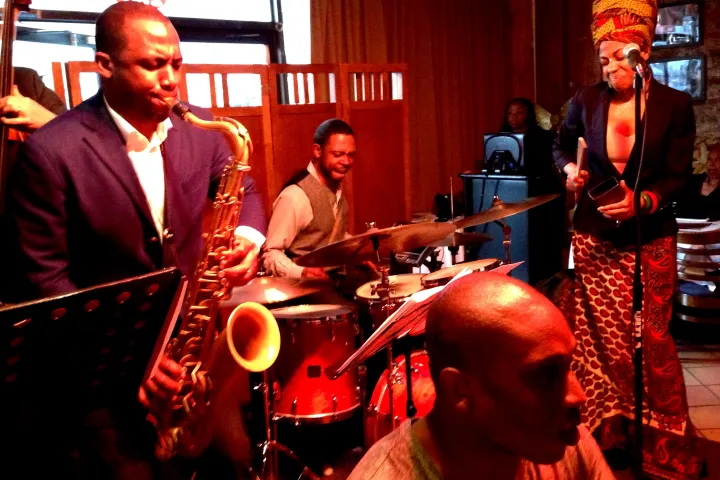
Harlem Juke Joint Tour
Your Harlem jazz tour guide customizes the best itinerary for each given night, based on the most talented players in Harlem’s most exciting jazz clubs.
185 Reviews

Harlem Juke Joint Tour
Your Harlem jazz tour guide customizes the best itinerary for each given night, based on the most talented players in Harlem’s most exciting jazz clubs.
185 Reviews
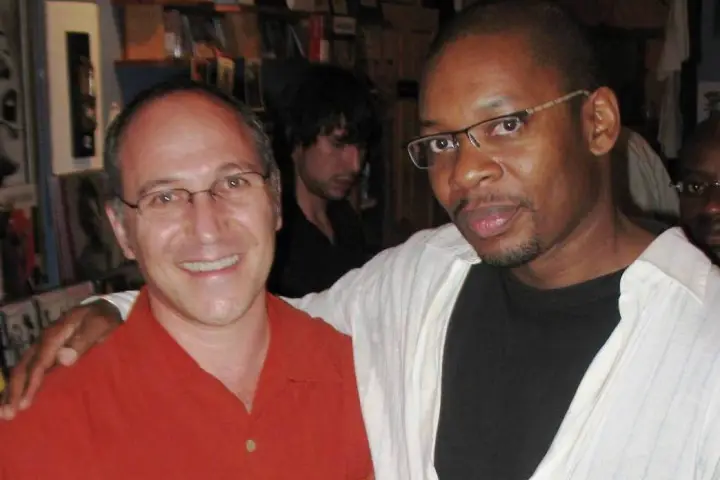
Legends of Jazz Tour
This is our premium tour! It features jazz’s international superstars, and also rising stars who deserve wider recognition.
185 Reviews

Legends of Jazz Tour
This is our premium tour! It features jazz’s international superstars, and also rising stars who deserve wider recognition.
185 Reviews

Greenwich Village Jazz Crawl
Intimate Greenwich Village Jazz Tour to discover and explore two hidden jazz haunts and the sites where Billie Holiday, Charlie Parker, and Bob Dylan made history.
185 Reviews

Greenwich Village Jazz Crawl
Intimate Greenwich Village Jazz Tour to discover and explore two hidden jazz haunts and the sites where Billie Holiday, Charlie Parker, and Bob Dylan made history.
185 Reviews
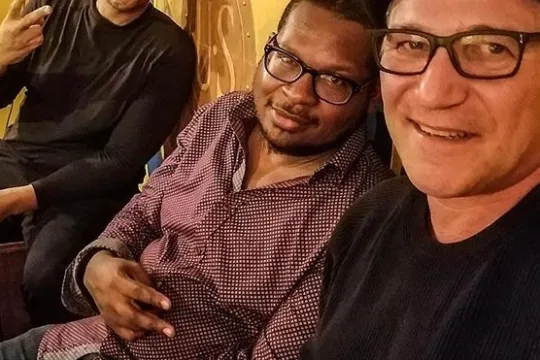
Private Tour
We’ll design your private jazz tour based on your tastes and our extensive knowledge of musicians, clubs and speakeasies throughout the city. We know what is happening nightly on and off-the-beaten-path.
185 Reviews

Private Tour
We’ll design your private jazz tour based on your tastes and our extensive knowledge of musicians, clubs and speakeasies throughout the city. We know what is happening nightly on and off-the-beaten-path.
185 Reviews

Gordon Polatnick
Gordon is the founder of Big Apple Jazz Tours. What started as a personal challenge to discover and document all of New York’s hundreds of jazz joints and to establish Harlem’s first jazz day club, has now blossomed…
Gordan Patrick Full Bio
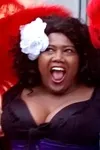
Amanda Humes
There’s no one in New York City like Amanda! Equal parts sass, smarts, and customer service – Amanda is the Harlem resident, Columbia University graduate, and…
Amanda Humes Full Bio
